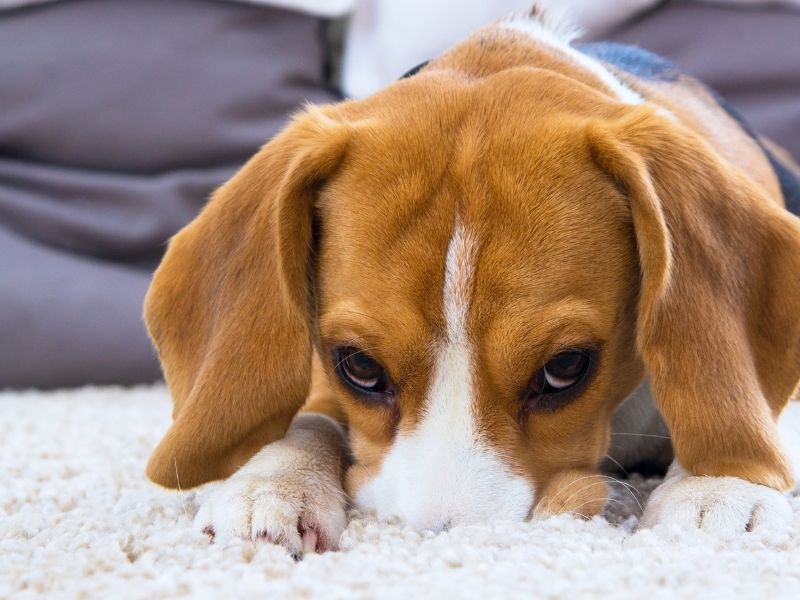
How to Stop a Dog from Marking in the House for Good
This post may include affiliate links. Please read my disclosure policy.
Urine marking is a common behavior, particularly in male dogs. Dogs mark with their urine to assert ownership of objects and areas, leaving a scent message for other dogs. Female dogs mark with their urine too, especially during their heat cycle. This natural behavior is a way for dogs to communicate and establish social hierarchy.
What’s the Difference Between Peeing and Marking?
Your dog may pee inside if they haven’t been let out enough, if they have a small bladder, or for many other reasons. But the peeing will result in a full puddle of urine.
Whereas, in marking, you’ll only find a small amount of urine, and it’s often found on the same spot or object.
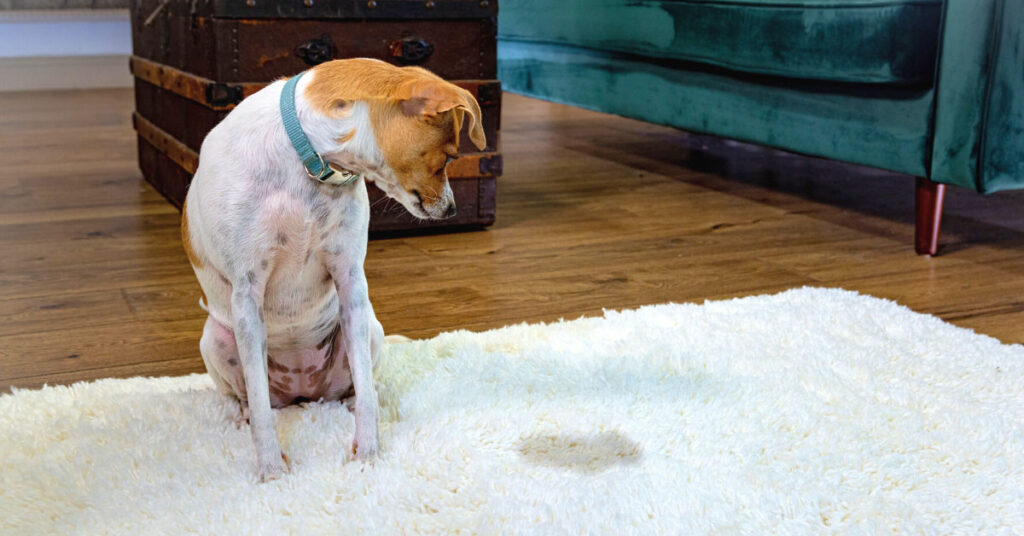
It’s considered natural behavior when dogs mark a certain spot, but it’s certainly not acceptable in the house. Furniture, floors, walls, and other items are ruined or damaged when your dog decides to claim them as his own.
Urine marking is not the result of faulty housebreaking. In fact, most of the time, urine marking can be curbed with behavior modification.
Why Is Your Dog Marking in Your House?
One of the most common reasons dogs start urine marking inside your home is the addition of anything or anyone new, be it a new dog or cat, a baby, a new partner, or even new furniture. This behavior can be particularly prevalent in multi-dog households where there’s competition for resources, attention, or status. By territory marking, a dog is basically saying, “This is my space. Keep out.”
Other triggers may be stress, like moving to a new home or even a change in your and your pup’s routine. Certain forms of anxiety, like separation anxiety, can also cause this behavior. Dogs urine mark as a coping mechanism, providing them with a sense of security and familiarity in response to perceived threats or changes.
If your dog urinates more frequently in your home, this may also indicate underlying health issues. Certain diseases may result in increased urination, which can be misconstrued as marking behavior.
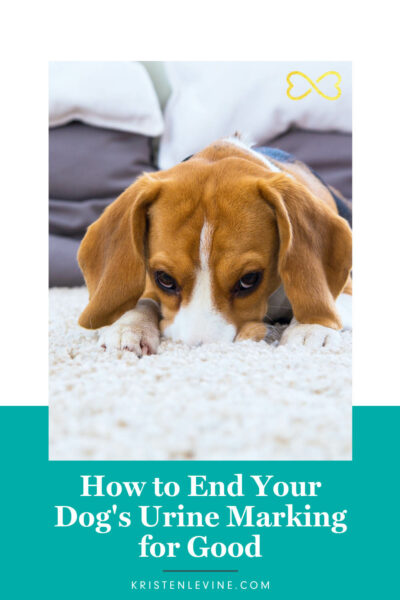
How to Stop Dog Marking in the House
Spay or Neuter Your Dog
For both female dogs and male dogs, spaying or neutering will reduce or stop marking behavior. According to the North American Veterinary Community, as many as 50% of male dogs stop scent marking, or at least do it significantly less often, after being neutered.
Intact male dogs usually begin marking when they start to reach sexual maturity.
If you have a puppy, neutering him as soon as he’s old enough is one of the best ways to stop indoor marking from starting in the first place.
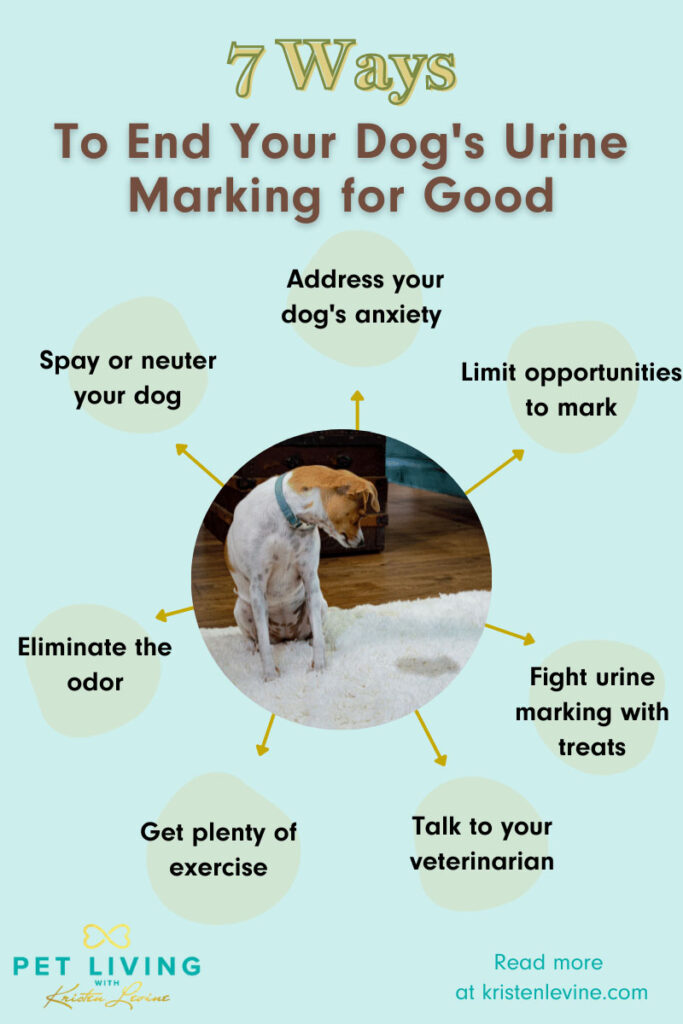
However, it may be days or even weeks for the urine marking behavior to stop after your dog is altered since hormones gradually decline rather than come to a screeching halt.
And it will likely also take some additional house training on your part to change the marking behavior if it has become a deeply ingrained habit.
If your male dog is peeing in the house weeks or months after he’s altered and after you’ve taken the steps below, there could be other behavioral or physical issues that need to be addressed.
Address Your Dog’s Anxiety
If your dog’s marking is caused by something like separation anxiety, you’ll want to address it sooner than later, especially since anxiety can escalate as your dog ages.
This is one reason why it’s important not to yell at your dog when he marks. If he’s doing it out of anxiety, yelling may make it much worse.
Some dogs experience noise anxiety, social anxiety, or separation anxiety. These fears can make a dog react with unwanted behaviors, like urine marking.
There are several OTC (over-the-counter) anxiety tools that can help alleviate your pup’s anxiety. I love this pheromone collar from Adaptil.
My dog, Chilly, had severe anxieties, especially around loud noises, and this collar was a very effective tool we used to manage it. The pheromones have a calming effect on some dogs and can reduce the urge to mark. There is also a room diffuser if you prefer that.
There are also many food-based remedies for calming anxiety, including calming probiotics and calming foods.
Ultimately, if your dog has anxiety, you may need to enlist the help of a veterinary behaviorist to work through it. You can find a behaviorist in your area using this page on the dacvb.org site.
You can also check out my pet anxiety resource page for more information about anxiety signs and solutions.
Eliminate the Odor
As long as the odor from your dog’s urine is still there, he’ll likely continue to mark the same spot. So it’s important to clean it up correctly, with a bio-enzymatic cleaner designed to eliminate biological waste, like urine. Be sure to let these completely dry to eliminate all traces of organic matter.
An enzyme cleaner works by eating the bacteria that’s causing odor and stains. Ordinary household cleaners will do little to eliminate the mess. If you’re in doubt, take a black light to any mess you’ve cleaned without using a bio-enzymatic cleaner, and you’ll be convinced!
Kinderbean No-Stress Mess Eraser is, paws-down, the best cleaner for pet mess, in my opinion. I’ve tested a lot of cleaners, and most have come up short in one way or another.
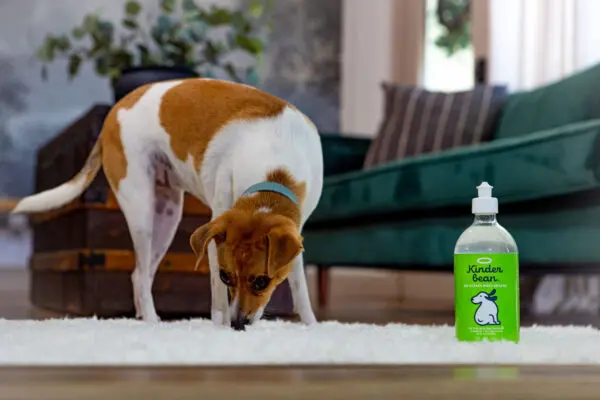
Whichever cleaner you choose, make sure it is:
- Bio-enzymatic
- Safe for pets (both in chemical composition and odor)
- Doesn’t contain harsh dyes that could discolor surfaces
- Contains natural ingredients
- Has a durable dispenser (many have cheap spray tops that break in shipping)
Once you have your cleaner, you need to use it properly to make sure it eliminates the odor.
- Soak up as much urine as possible with a paper towel.
- Saturate the spot with the cleaner. This is important so it can make contact with the urine and eat the bacteria.
- If the spot is horizontal, lay a clean cloth over the top and allow it to set overnight or 12–24 hours. If the spot is vertical, allow the cleaner to air dry.
- Retreat if necessary.
It’s a very simple process, but it’s so important not to simply “spray and wipe away.”
- Enzyme-Powered Cleaner: Simple ingredients, powered by plants. Powerful, bio-enzymatic formula biodegrades odor and stain molecules leaving nothing behind.
- Any Stain, Any Surface: Erases pee, poop, vomit, blood and scoot stains from all floor and furniture surfaces including carpets, upholstery, hard floors and more - even cleans leashes, collars and pet bedding.
- Easy to Use: In just three steps, this ready-to-use cleaning formula will erase messy stains and odors for good - no mixing, just shake and go.
- Safe for Pets & the Earth: Our non-toxic blend of safe probiotics and naturally occurring enzymes have no harsh chemicals, no scary additives, no residue and no possibility of harm to your family or pets.
- Created by a Pet Expert: Pet industry veteran and lifelong pet parent Kristen Levine created Kinderbean to make loving pets easier, messes and all.
Fight Urine Marking with Treats
Most dogs won’t pee where they eat. Change the meaning of the place he has marked by leaving treats directly on the spot after cleaning it.
Consistency is key here because as soon as you’ve banished one area as a pee spot, your dog may choose a new area. It may take weeks before your dog realizes the entire house is off-limits to territory marking. But this solution is usually permanent, so it’s worth the wait.
I like to use these treats because they’re low in calories and all-natural. When you’re dog training, you’ll go through a lot of treats, so you don’t want to give them full-size bones or cookies that will pack on unhealthy pounds.
Get Plenty of Exercise, Both in Body and Mind
Breeds known for their high energy or above-normal intelligence are in special need of exercise. Getting out that pent-up physical or mental energy can help calm your dog and avoid behavioral issues, such as marking.
If you’re already walking your dog and he’s still peeing indoors, you may need to step up your game and either walk him longer or take him for a run.
If running doesn’t get you paws-itively excited, try taking your dog to the park for a game of high-intensity fetch. One of my favorite fetch toys is the ChuckIt! Ring Chaser. It allows you to throw a ring-like toy long distances without tiring out your arm. Plus, it bounces and rolls in ways that are really enticing to our energetic pooches!
Brain stimulation is also important, so come up with creative games or tricks to teach your pet. Not only will it give your pup a purpose, it comes with the benefit of increased bonding time with you!
Exercise may seem like a very simple step, but it’s probably one of the most important!
Limit Opportunities to Mark
If your dog is a stubborn marker, you may need to take stricter measures to curb the behavior.
Some experts recommend the umbilical cord method. When your dog is inside, he’ll remain leashed to you so you can closely monitor him. As his behavior improves, you can gradually give him more freedom to explore the house.
I’ve tried this method to housebreak my dog, Tulip, and it works fantastically. I’ll caution, though, that you do need a lot of patience and consistency to see results.
When to See Your Veterinarian
In most cases, behavior modification is enough to curb your dog’s urine marking. However, in some cases, urine marking can be caused by medical issues.
Your dog may have begun marking because of a urinary tract infection, and the only way to know for sure is to visit your veterinarian.
If your dog has begun marking and there doesn’t seem to be any apparent trigger, it’s time to visit your veterinarian to rule out anything that needs treatment.
Additionally, if your dog has extreme anxiety that’s causing the urine marking, you may need to seek help from a veterinary behaviorist. They can help get your dog the relief he needs and recommend more ways and methods on how to stop a dog from marking in the house.
When Is Urine Marking Acceptable?
When you’re walking your pup, urine marking outdoors should be all right. If you’re in an area where marking would not be acceptable, perhaps like your neighbor’s beloved garden or flower bed, take note of any tell-tale signs that your dog is about to mark, like prolonged sniffing. Lead your pup away from the area by encouraging them to move along (use the voice that you know gets lots of wags) and offer treats if you have any on you.
The Tail End
If your dog is urine marking in the house, rest assured it’s not because he wasn’t house trained enough. Urine marking is a behavior, and with behavioral modification along with neutering your dog, you can stop marking for good.





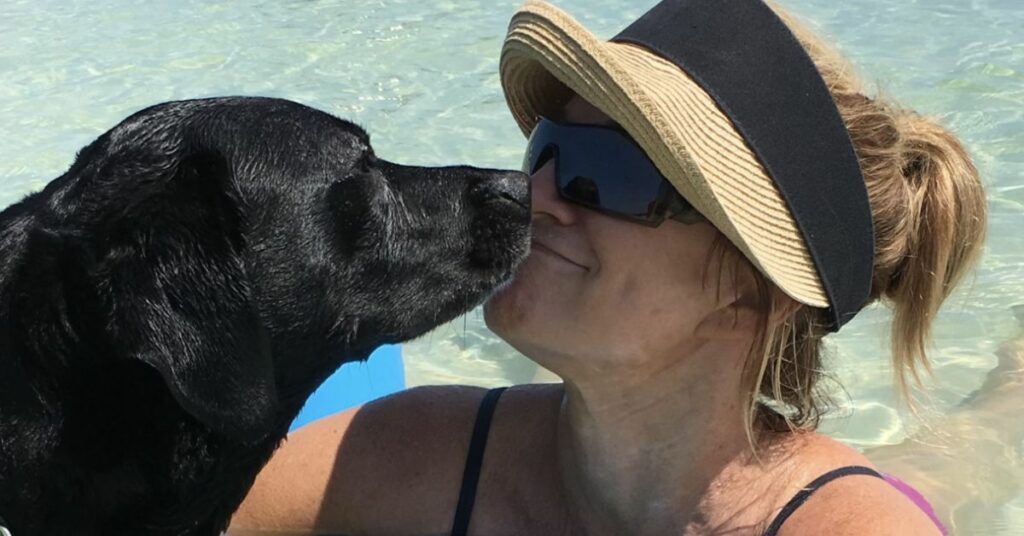
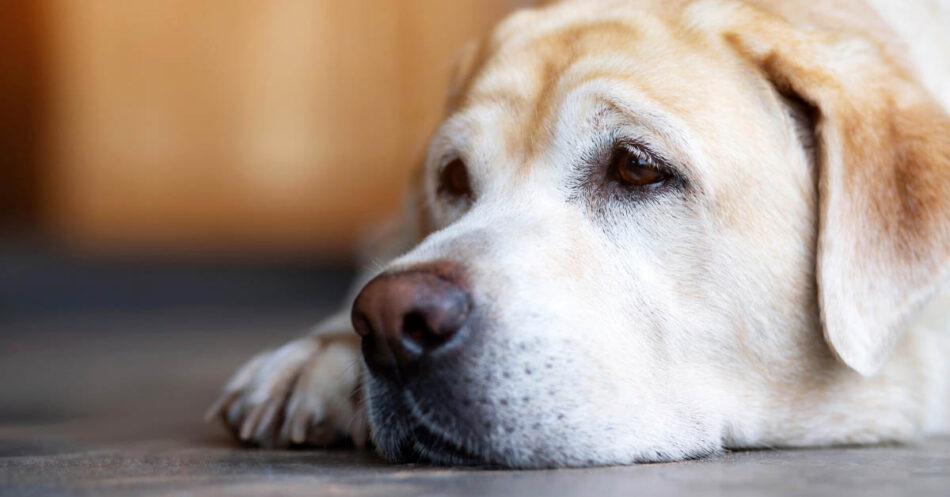
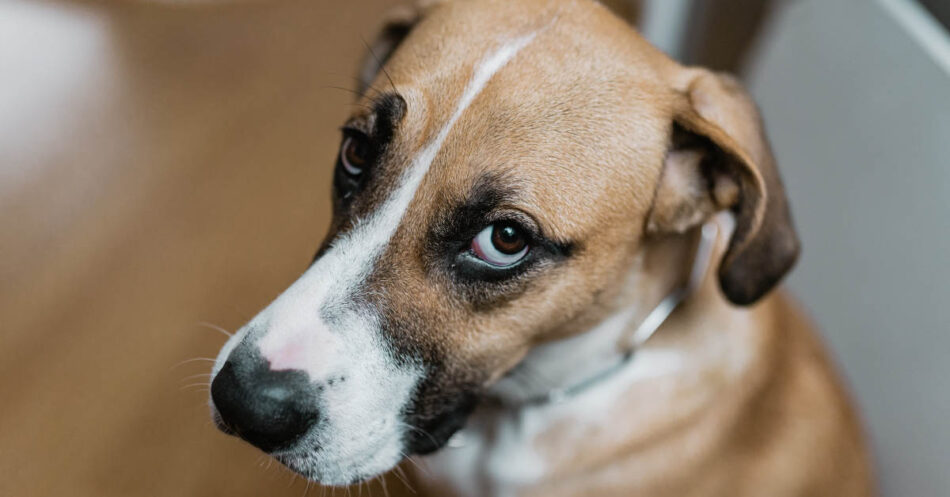
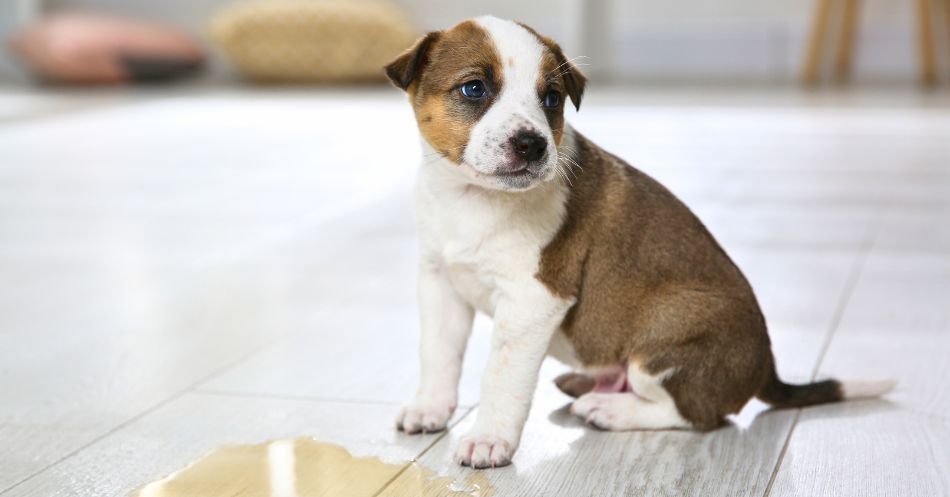
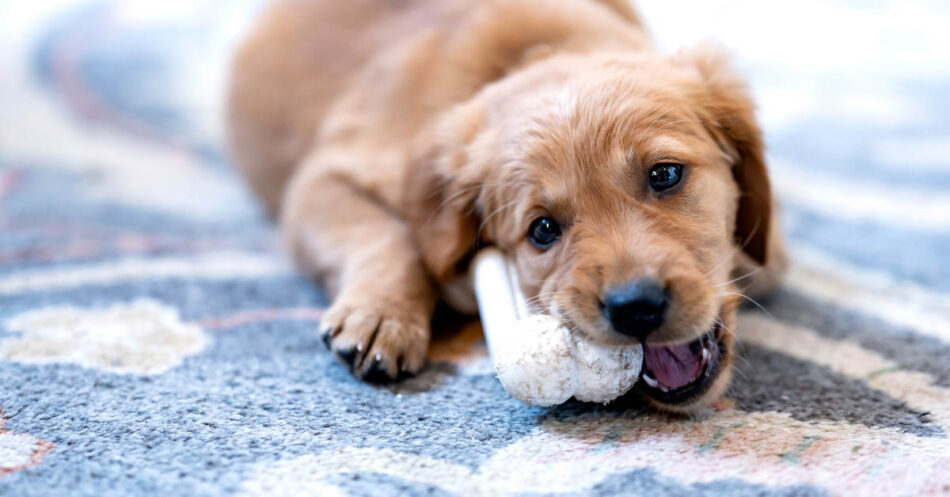
I have a 7.5 year old dog that has been marking in the house for about a year now. I know this started due to a foster we took in that was not fixed who started marking. That foster however has been gone since November 2019 and he is still marking. We do have another foster but they get along. There are no dominance issues. He marks mainly on the baseboards in my kitchen and foyer and the doors to my laundry room. He also marks on their kennel in the laundry room, but has no problem sitting in the kennel during the day. This room is also where we feed them. We keep a close eye on him during the day, but as soon as he is left alone he will mark and no one sees it. He does this outside as well, but it doesn’t matter if we are watching. I can’t catch him in the act so I am having the hardest time training him to stop. Suggestions?
Kisha,
Ugh! That sure is frustrating. My guess is that he still smells the urine from before when he first began marking. Is he neutered? That could help to solve the problem. You need to really clean the areas where he marks with a cleaner that will take out all of the scent. That way, he can’t smell it anymore and will be less likely to mark there in the future. If you do catch him in the act, be sure to take him outside after to try to redirect the behavior. But, I know that is hard to catch! Try this cleaner, and be sure to follow the instructions to get the best clean.
Hope this helps! Stick with it, I know it’s hard. Keep me posted!
Kristen
We have 1 girl pug mix (10 yo) and 2 pug boys (5 & 4 yo). All spayed & neutered and have had all since they were puppies. The 4 yo pug boy will not stop marking – inside or outside. We’ve started crating him again when not home to reestablish training, but even when he empties his bladder outside, he’ll come right inside and lift his leg and mark or pee all over again on something. I don’t want to crate him when I’m home too but cannot watch him every second of the day.
Help!
Hi Joanne,
I’m sorry you’re struggling with your pug boy! Does he tend to mark the same area/s each time? If so, try moving his food dish to that area. Dogs will rarely mark where they feed.
If he randomly marks around the house, I recommend you see your vet to rule out a medical issue. Alternatively, he could be experiencing anxiety about something — that’s another reason for neutered male marking. Has anything changed in the home?
Another thing you can do is consult a veterinary behaviorist to help identify the cause and develop a behavior modification plan, possibly including a calming medication or supplement.
Keep me posted on progess.
Kristen
My 8 year old dog has started marking since my daughter was born. She’s almost 3 and he’s starting to do it more and more when he never had an issue before. She’s not the nicest to him and he’s definitely scared and nervous because of her. I want to find out what I can use as a deterrent.
PLEASE people get your pets spayed & neutered. This is number one & contributes to the overpopulation of dogs in the USA. Neutering your male dogs will definitely help with marking & aggression towards any other dogs. Not only that testicular cancer, female cancers & pyometra in unspayed older females is not something you want to put your pet through if you truly care about them! Pyometra is painful & can be fatal.
Try putting Uncle Ian’s Dog/Cat Repellent into a nylon stocking & hang it from the area where they are marking. Be sure to clean the area with bleach or an enzymatic cleaner first to remove the scent of their urine.
I run a senior dog sanctuary so have had many dogs come to us from shelters who are not potty trained. They all want to mark when they first get here. I have a ton of experience in this area. I leave wee wee pads in one area & train them to go in that spot to pee. You can also place a wooden fire log on the wee wee pad so it entices them to pee there.
Good luck!
Thanks for weighing in with your experience Shelley! And thank you for the work you do for senior dogs!!!!
Kristen
Don’t know if you can advise me. I have a now 3 year old little Pomeranian. He wasn’t the best potty trained at our old house but since moving to our new house a year and a half ago he marks everywhere. We won’t pee normally outside but will spray up every plant pot, chair etc and he also does it in the house. I can’t work out a pattern and he will often suprise me doing it in new locations. I am at my wits end with it. We are in a 3 storey house and I have almost 2 year old twins which he has had to adapt with. I never took him to training as after I fell pregnant it took a back seat but he is relatively well behaved apart from the peeing. The only other thing is his barking and he doesn’t like to be left alone either. Someone suggested starting from scratch with puppy training but is this going to address the marking issue
Hi Emma,
That is frustrating! Is he neutered? That would be my number one recommendation as that usually corrects the issue. Every time he goes in the house, put him outside so he knows that is where he is supposed to pee. Additionally, be sure to clean the area extremely well with an enzyme cleaner to help get the scent out of the area completely. Puppy training could definitely help! If he completes training he will be more likely to listen to your commands. Good luck! I know this issue is so difficult to manage. Here is a good cleaner that I recommend you use.
Keep me posted!
Kristen
Hi. Thanks for the suggestion. He is neutered so i am guessing that i am not getting all the smells out since its always the same spots. We’ll try the solution you suggested and let you know.
Kisha
I cannot get an answer from the internet. I have a shih tzu long hair Chihuahua mix 3 years old this past June who has been neutered since April of 18. Which would make him 10 months old at the time of being neutered. Who loves to Mark the furniture in the house. And he likes to poop on the bed at certain times .he has been pee pad train since the day we brought him home and he was 7 weeks old at that time, he’s very smart he knows to use the pee pad but here lately the last 11 months has gotten worse, he’s a very smart young man he knows what he’s doing is wrong. How do I stop him.. please help
Hi Steven,
Gosh that is so frustrating. Has he had any recent changes in his routine? I ask because changes in his routine can cause stress leading to marking. Also, pee pads are great for training, but if you keep them in the house after they are potty trained, he will begin to think that is it okay to pee and poop in the house. So, he might not understand why he can pee on the pad, but not on the couch.
My number one recommendation would be to check with your vet. There could be an underlying medical condition that is the cause, like a UTI. Also, be sure to clean the areas he marks really, really well. If he can smell the urine from the last time he went, he will be more likely to mark there again. I like this cleaner.
I hope this helps! Keep me posted.
Kristen
A lot has changed here since November of last year my fiance’s daughter moved in we have another little puppy that will be a year old this month, and now a 7 mt old cat.. he does not get along with either one he tolerates them but growls at them when they get within his space he likes to poop on my fiance’s daughter’s bed. When you catch him and you call his name out he looks down or looks away.
Hi Steven,
Yes it sounds like he could be marking due to all of these changes in his routine. It could even be anxiety related since so much has changed. With new animals in the house, he could also be trying to mark his territory. I would definitely consider talking to your vet about this to see if they have any solutions for him. Additionally, he could benefit from seeing a certified animal behaviorist, as they can help determine the root cause of his marking and work with him to fix it.
Also, be sure to clean the areas he marks really well with an enzyme cleaner, like this one, each time he marks. That is to ensure that he cannot smell it after he goes. If he can still smell it, he will be more likely to mark there again.
I hope this helps! Keep me posted!
Kristen
I’m not sure what to do with my dog. She is a 4 year old house trained dog and she has never marked in my home before but the last 6 months she has been marking a certain corner and she only does this when she is left alone. She is well aware of her punishment which is going out onto the balcony. I came home after leaving alone for 20 minutes and she marked in the same spot even thought I just had my carpets cleaned. Right when I came home she was waiting by the balcony door I take her out for a potty break before I leave but she will still mark this spot. I cannot leave her outside because she barks the entire time and I have received complaints.
Hi Michelle,
That is such a difficult issue. Do you clean the area with enzyme cleaner every time she goes? This is important to ensure you are getting the smell out of the carpet entirely.
My number one recommendation is to check with your vet since they can check for an underlying medical condition like a UTI. In the last 6 months has her routine changed? If you began working from home and then left to go back to the office again, that could cause her some anxiety. Also, has she been spayed? Spayed dogs are less likely to mark.
I know this is such a difficult issue. It may take some trial and error, but it’s not hopeless! I hope this helps.
Kristen
I have a German Shepherd mix (10yr-female) and her daughter, a black lab/German Shepherd mix (8yr). The brother often comes to visit every weekend. About 5 years ago, they all belonged to me and we never had any accidents. Since he began living away, though, he started having house accidents. This never happened in my house, but I was told it happened in his new home. Just now, it happened for the first time right in front of us in our home. We immediately corrected it and had him sit in the corner while we sprayed the area down and cleaned. He gets plenty of attention when he’s over here, so I don’t believe he’s feeling insecure, but he has not been fixed. I’ve offered the option, but my husband won’t have it. The two female dogs are fixed. Is there anything else you might suggest now that we’ve caught it early? He is a very well-behaved, obedient and calm dog. Thank you!
Hi Allisa,
That’s such a tough issue! The new marking behavior is likely due to the change in his environment. Dogs are territorial, so moving homes can cause stress. When he is in your home, he is trying to mark his territory. This is especially common in un-neutered males. If neutering is not an option, I would recommend putting Adaptil diffusers in his new home and in your home. The diffusers communicate all natural “happy messages” to the dog and can help him feel calmer in his new environment. When he marks, put him outside so he knows that is where he should be going to the bathroom. Then, clean the area completely with an enzyme cleaner, like this one, so that the scent is completely out of the area. If he can still smell the urine, he will be more likely to mark there again in the future.
I hope this helps! Good luck.
Kristen
Hello!
I hope that you can help me. I have a 6 YO male Bullmastiff (who is not neutered).
When he was a puppy we potty trained him but as soon as my nephew was born he started peeing in the house, mostly on his toys. After getting use to my nephew (who is now 3 Y.O) he stopped peeing on his toys. Now from time to time he pees on the living room couch and a curtain next to the couch. It’s impossible to catch him doing it as well. He does it quickly then runs upstairs or avoids that area all together because he knows that he has done something wrong.
In terms of his personality. He’s a very gentle dog who was very fearful when we first got him as a puppy. He was the last puppy in his litter and was born smaller than the other pups so he didn’t get a lot of his mother’s milk according to his mother’s owner. When he was younger he use to hide when someone rang the doorbell but he has come a long way now and is one of the first to run downstairs when someone comes. However, he still has a bit of timidity and is afraid of vehicles so he doesn’t like going for walks near main roads. I don’t know whether his personality has something to do with it.
Aw, I am so sorry to hear this!
This could be anxiety related. Since your nephew was born, he has had a change in his routine which can cause stress. And, it sounds like he has a timid nature in general. Putting Adaptil diffusers in the rooms he marks in could be a good way to help calm him down. These release natural, calming messages for canines into the air which can make him feel more comfortable in his environment.
Is neutering him an option? That is always my number one recommendation with un-neutered marking males. They are less likely to mark their territory once they have been neutered.
Keep me posted! I hope this helps!
Kristen